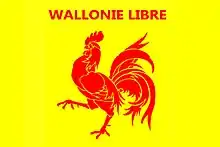Wallonie Libre
Wallonie libre (French; literally "Free Wallonia" by analogy to Free France) was a group within the Belgian Resistance during the German occupation of Belgium during World War II which subsequently became a small political party. Part of the Walloon Movement politically, its ideology became increasingly radical in the post-war period.

History
Resistance group, 1940–44
Wallonie libre originated as a political association of Walloon migrants in Brussels before World War II which was known as the Walloon Guard (Garde wallonne).[1] It was heavily influenced by the radical Walloon Movement which supported the secession of Wallonia and its merger into France.
The group was re-formed in the aftermath of the Battle of Belgium (10–28 May 1940) to provide aid to the French which were still fighting Nazi Germany. Wallonie libre was purportedly established on 18 June 1940 during the Garde's annual gathering to commemorate the anniversary of the Battle of Waterloo which coincided with the radio broadcast of the Appeal of 18 June by the French General Charles de Gaulle.[2] The name Wallonie libre was consciously chosen as a counterpart to de Gaulle's own France libre (Free France).[1]
Wallonie libre is therefore sometimes credited as the earliest Belgian Resistance group.[2] During the occupation, Wallonie libre produced an underground newspaper called La Wallonie Libre and another in Liège entitled Sambre et Meuse.[1] It became close to parts of the Communist Party of Belgium in 1941. In August 1942, it was absorbed into the larger left-wing Front de l'Indépendance (Independence Front) group.[1]
Political party, 1944—
After the Liberation in 1944, Wallonie Libre became a political movement. It organised the Walloon National Congress, held on 20-1 October 1945.[1] After a period of dormancy, it was revived during the resurgence of the Walloon Movement in 1960.[1] It organised the so-called Combat Wallon (Walloon Combat), leading to the 1980 Congress where the movement began to call for complete Walloon independence. In 2005, Jacques Rogissart, the then-leader of Wallonie Libre decided to join the Rassemblement Wallonie-France ("Wallonia-France Rally"), led by Paul-Henry Gendebien. He created a counter-organization called Nouvelle Wallonie Libre ("New Free Wallonia"). He was replaced by Jacques Dupont.
References
- CRISP 1968.
- Delforge, Paul. "18 juin 1940 : naissance de Wallonie libre, premier mouvement wallon de résistance". Connaitre la Wallonie. Retrieved 29 July 2017.
